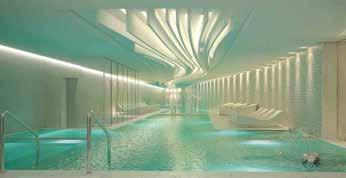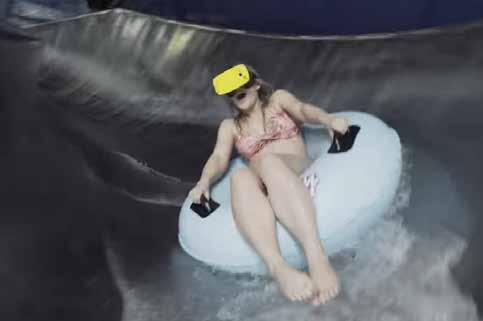
10 minute read
Water World
Warren and Mahoney’s concept for the Christchurch Metro Sports Facility (above) and Myrtha designed relaxation pool (below).
IAKS document charts future global trends for public pools Water World
Advertisement
The Germany-based International Association for Sports and Leisure Facilities (IAKS) has explored future trends for the global aquatics industry, explaining the role of public swimming facilities as places of inclusivity, as places for socialising and for sport while also exploring how they can operate as ‘wellness hubs’.
Introduced at the International Swimming Pool and Wellness Forum during the FSB convention in the city of Cologne on 7th November, the IAKS Future Trends for Pools initiative is based on issues and trends observed by international experts.
Introducing the document, IAKS President Dr Stefan Kannewischer stated “these future trends outline important developments for professionals and non-professionals involved in pools around the world.”
Key to the document, is an appreciation that swimming and water-based leisure activities have always been a human need that deliver physical and emotional benefits.
It explains “the way people are taking the waters has changed and will continue to change over time, so pool facilities will have to adapt to evolving user behaviour accordingly.”
The IAKS pool expert circle has identified the following IAKS future trends for public pools (which does not include hotel pools) detailing future trends for professionals and nonprofessionals (such as politicians and other stakeholders) involved in pools around the world.

Swimming is regaining importance
The individualisation of our society and new ways of working, with blurring boundaries between work and leisure, are leading to stronger on-demand activities like swimming, jogging and cycling. These are often performed in public spaces that are not limited by opening hours. This means that more access to lap swimming for all (not only for competition) is needed and that opening hours should be extended.
Immersing in a lifelong healthy lifestyle
Water sports and swimming fit in perfectly with the trend of people leading more healthy lifestyles coupled with an ageing society with more active seniors. This is why water-based exercise classes, as a gentle start to an active lifestyle, and swimming lessons for adults are becoming more popular.
As many children are not taught to swim any more by their parents, swimming lessons for children (in school or as a leisure activity) are becoming more important.
These activities can often be accommodated in learner/ teaching pools and are better supported with an adjustable/ movable floor (multifunctional pools).
Pools are turning into ‘wellness hubs’
The increasing importance of ‘preventive health care’ (including mental health/stress reduction) is encouraging holistic life-style activities. The combination of sports with relaxation activities is gaining in importance, so wellness offerings are being added more frequently to classical competition pools, e.g. warm water/spa pools, sauna/steam rooms, treatment areas, lounging zones.
German-speaking Europe has a strong wellness-oriented bathing culture with the pool infrastructure designed to support this. However, the added wellness offerings at smaller and more competition-oriented pools should be closely analysed for their economic benefits.
The healthy eating trend is boosting demand for healthier food offerings at pools.
SWIMWALL SYSTEMS ™

AIR OPERATION RETRO-FIT NEW POOLS CUSTOM DESIGN
SEPARATION SOLUTIONS TO OPTIMISE POOL SPACE
SwimWall Systems™ provide unprecedented flexibility to divide your swimming pool into multiple activity areas. New revenue opportunities are created by fully utilising the entire pool at all times employing our flexible wall system. This system can effectively double the number of pool lanes or create 50m and 25m lanes in the same pool! SwimWall Systems™ are suitable for both new construction and retrofit to existing pools. Wall heights and widths can be customised to suit pool requirements. The walls inflate within one minute and fold conveniently flat on the pool floor when not in use.
Typical Installations:
New pool construction Griffith University QLD

[Rebated] Retrofit installation Cockburn ARC WA

[Concrete Tiled]

Retrofit Myrtha Pool Installation University of Bath UK
[Vinyl]
For more information on SwimWall Systems™ contact S.R.Smith 07 3812 2283 • info-au@srsmith.com • www.srsmith.com/au
SERIOUS EQUIPMENT
SERIOUS FUN ACCESS FOR ALL
The City of Sydney’s new Gunyama Park Aquatic and Recreation Centre - designed by Andrew Burges Architects in association with Grimshaw and TCL.

Fun for children and families
In addition to the wellness trend, children and families are a core target group for pools. Having fun is important for children and families as an introduction to the water and for leisure. To support this, facilities need to be more attractive and provide amenities focused on fun.
Designing for inclusivity
The original conception of accessibility focused on the needs of people with visual and mobility impairments. This has expanded significantly in recent years as society becomes more inclusive. This has also been driven by demographic change, migration and increasing cultural diversity. Social sustainability and inclusion have become important goals for public leisure facilities.
The political decision-making process is therefore increasingly involving all stakeholders and the public from the beginning. It should start by defining the socio-economic outcomes and political goals of a new project.
Inclusivity requirements are resulting in new design strategies for many aspects of pools including stairs, lighting, signage, surfaces and acoustics, as well as for universal changing areas and toilets.
Cultural and demographic differences are also driving increasing demand for privacy strategies so that certain groups can be better accommodated.

The completed Taiora QEII in Christchurch.
Pools as place for socialising
The social function of sports and leisure facilities is growing in importance. Facilities need to be multifunctional and serve as a ‘social hub’ for the community. This is best accomplished if the facility integrates all stakeholders and seeks close relations with users.
Sports and leisure facilities also play an important role in supporting and encouraging participation by adolescents, and this has many positive social outcomes in the broader community.
Sustainable and healthy pool facilities
Climate change places a new focus on ecological sustainability. This necessitates a holistic approach from planning and construction through to the operation of pools with a minimal ecological footprint. Important strategies include water conservation, heat recovery, combined heat and power generation, solar energy, passive house principles, and waste/ plastic reduction.
Health consciousness also calls for better air and water quality and includes a desire for reduced concentrations of by-products of chlorine disinfection. Consequently, higher technical standards (together with tighter regulations) are resulting in increased investment costs for pool projects.
In some regions, the increasing awareness of climate change is resulting in a call for more protection of facilities from the sun and rain. Air pollution poses new challenges and imposes limitations on outdoor activities.
Safe and secure pools
The potential for antisocial behaviour calls for measures such as video surveillance and security teams.
The increasing responsibility and liability of leisure facilities towards their users raises the need for more surveillance staff, surveillance technology (e.g. underwater surveillance systems), and more complex building construction and makes the use of certified products more important.
Competing demands on public finances
The competing demands on public finances call for a prioritisation of investments. In competition for public funding, promoters of pool projects have to communicate the significant ‘public value’ of pools (also known as the ‘social return on investment’) to government and other stakeholders.
In response to financial pressures, new projects can be
AUSTSWIM TEACH A SKILL
FOR LIFE!

TOLL FREE 1300 885 666 www.austswim.com.au
executed in partnership models with not-for-profit or private commercial companies.
Improving economics
Long-term business plans (including life-cycle costing and financing) are crucial steps towards achieving a good longterm financial outcome.
Financial performance can also be improved in multicomponent facilities by combining profitable life-style sports with traditionally unprofitable activities and sports, e.g. adding leisure elements or a fitness club to a competition pool, or by combining pools with other non-sport municipal functions. Sport England promotes this kind of combination, e.g. combining the pool, sports hall and fitness club with a library.
Furthermore, regional pool planning increases effectiveness. Especially where seasonal outdoor and indoor pools are in different locations, it makes sense to manage them jointly at one location. Also, the duplication of similar pools should be avoided in the same catchment area.
Revisiting the business case is also very important when old pools need refurbishment.
Finally, pool management usually has the highest economic leverage on revenues, and especially admission fees (rather than costs), and pools should be managed professionally (rather than politically).
Digital transformation
The omnipresence of digital technology makes the digital accessibility of sports and leisure facilities indispensable, before, during and after the visit. Furthermore, virtual and augmented reality will make inroads into sports and leisure (facilities), e.g. the first virtual reality water slides are being installed.
Another development is an increasing demand for sports tracking/performance measurement.
New admission control and (noncash) payment systems will transform service quality for users and reduce staffing requirements.
In marketing, mass media communication is declining and individualised marketing is increasing, e.g. social media, Google Adwords.
All this collected data raises the complexity of data security, privacy expectations and regulatory compliance (such as Europe’s General Data Protection Regulation).
In project design, the use of building information modelling is increasing and may lead to better integration with operational systems, but its consequences for the business concept should be closely watched.
International harmonisation of demand
Globalisation, the internet and people’s increasing mobility are influencing user expectations. Users’ demands are heavily influenced by international best-practice pools. Global trends should therefore be monitored closely, with the growing harmonisation of international quality standards.
Diverse development of market segments
Commercial life-style sports are often serviced by privately financed and operated sports and leisure facilities such as fitness clubs, wellness/sauna facilities and thermal baths.
This trend can leave municipal and school facilities lagging behind with the more unprofitable sports segments (e.g. competition pools) and without the opportunity for crossfinancing with profitable sport segments. This puts additional strain on municipal facilities where the return on investment is more social than purely financial. In these cases, an assessment of the public value is necessary. VRSlide, which recently opened at Galaxy Erding in Germany, and claims to the title of “first virtual reality water slide.”

Myrtha designed Wellness Steam Bath.

Scarcity of space
Increasing urbanisation is putting pressure on limited public open space.
These spaces therefore need to become more multifunctional and to allow physical activities of many kinds.
For example, seasonal outdoor pools can be used outside their normal operating season as park space or in winter for ice skating.
Good design
The delivery and operation of successful pools are complex tasks. Good design is an essential part of providing an enhanced user experience that fosters long-term loyalty and high participation. The complete quality of the swimming experience is a critical component for long-term success.
For more information go to www.iaks.sport
SUPPLYING, INSTALLING & SERVICING THE BEST IN SPORTS TECHNOLOGY
NEW SURFACE AND COLOUR OPTIONS CONNECT CONVERT GROW



www.sportstiming.com.au www.htsgroup.co.nz Australia: +61 3 9338 1077 New Zealand: +64 4 939 1010 SUPPORTING ARCHITECTS, FACILITIES & CLUBS MYMEMBERSALES IS THE MOBILE-FRIENDLY LEAD MANAGAEMENT SOLUTION THAT CAN HELP YOU GROW YOUR MEMBER BASE. VISIT WWW.MYMEMBERSALES.COM CALL US FOR A DEMO AUS - 1300 858 840 NZ - 0508 236 826
Panoramic Flying Attraction



Tasks and diaries Automated messages Lead allocation Real-time reporting.

MyMemberSales is brought to you by Jonas Leisure.
Grow your membership base Capture new leads for your business Streamline the sales journey Track your business success.

SIMPLE YET SMART

UDIO IS THE CLOUD-BASED, FLEXIBLE AND EASY-TO-USE SWIM SCHOOL MANAGEMENT SOLUTION.










